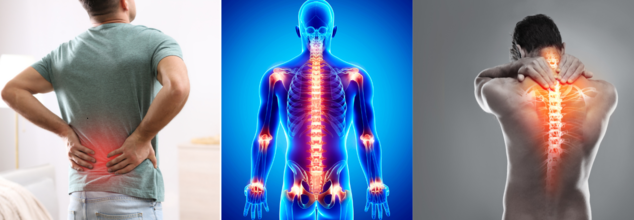
Credits: Canva
These Moves Can Keep Your Body Pain Away
If you often struggle with your posture, then this is for you. There are certain things you can do that can help you relieve that stiffness in your neck, or the dull ache in your lower back. The reasons could be many - including scrolling on your phone, binge-watching a show, chopping vegetables, or even a full night's sleep, because, you slept wrong. Experts believe that when you are more mindful of how you sit, stand, or even sleep, and move, it can help reduce discomfort and leave you feeling more energized.
Here are some posture-friendly strategies you can incorporate into everyday activities:
Upgrade Your Desk Setup
A poorly set up desk is a common cause of back and neck pain, especially for those working from home. To create a more ergonomic workspace:
- Sit about an arm’s length away from your monitor.
- Keep your shoulders relaxed and your arms comfortably by your sides.
- Your elbows should form a 90-degree angle, and both your thighs and forearms should be parallel to the floor.
- Make sure your feet rest flat on the ground and that your chair offers proper back support.
- This simple setup can prevent fatigue and long-term strain on your muscles.
Ease the Strain While Cooking
Even routine kitchen tasks can contribute to discomfort if you’re standing for long periods or working in awkward positions. Here are some tips:
- Use a stool or chair when possible to reduce time spent standing.
- Try anti-fatigue mats, which encourage subtle leg movements and reduce pressure on your lower back.
- Switch to tools like a mezzaluna or upright-handled knife that minimize wrist and hand strain with a more natural chopping motion.
Read Without the Neck Pain
- If you tend to look down at a phone or tablet for long stretches, you’re likely straining your neck. Holding your device at eye level helps maintain a neutral spine position and reduces tension.
- Consider using an adjustable stand for your phone, e-reader, or book, especially when lying in bed or lounging on a couch.
- Keeping your head upright prevents your neck from constantly working against gravity, which can lead to long-term discomfort.
Watch TV the Right Way
Settling in for a long viewing session? Proper posture can make your downtime more comfortable.
- Place a pillow behind your neck to support your head and reduce strain.
- Sit facing the screen directly, so your neck isn't twisted to one side for hours.
- This can make a big difference during long movie nights or weekend series marathons.
Support Your Sleep Posture
Your sleeping position matters more than you might think. Experts recommend the following:
- Use a supportive pillow that maintains the natural curve of your spine.
- For back sleepers, place a pillow under your knees.
- For side sleepers, use a pillow between your knees to align your hips.
- Avoid sleeping on your stomach, which can strain both your back and neck. If you're trying to switch, hug a body pillow to help ease the transition.
Move Regularly to Stay Pain-Free
Remaining in one position—no matter how "perfect" your posture is—can still cause fatigue. Change things up frequently:
- Take breaks every 20 minutes.
- Stand, stretch, walk, or do a few gentle exercises like lunges, wall sits, or planks.
- Keeping your muscles engaged throughout the day helps prevent stiffness and discomfort.

Credit: Canva
Creatine Might Not Be the Muscle-Building Miracle It's Hailed to Be, Study Finds
For years, bodybuilders and weightlifters chasing muscle gains and faster recovery have turned to creatine, a popular sports supplement. Promoted as a reliable aid for building strength and speeding up post-workout repair, creatine has enjoyed a solid reputation in the fitness world. But new research suggests that its benefits may not be as significant as previously thought.
A recent study conducted by scientists from Australia, Canada, and the United States challenges long-standing assumptions about the supplement’s effectiveness. According to their findings, published in the journal Nutrients, creatine offers little to no additional benefit in building lean muscle when combined with resistance training.
“In contrast to previous findings, the results of this study showed that creatine had no additive effect on lean body mass changes when combined with resistance training,” the researchers wrote. This conclusion adds a new layer of complexity to the ongoing debate about creatine’s true role in muscle development.
The study also raises concerns about the potential risks of higher doses. The researchers pointed to a possible “confounding” effect—or lack thereof—which suggests that in order to observe a noticeable muscle-building benefit, larger and potentially unsafe amounts of creatine might be required. This not only questions the efficacy of the supplement but also brings into focus the health risks tied to its excessive use.
Creatine is a chemical compound found naturally in the body and in several foods including meat, fish, and protein-rich plant-based sources like tofu, tempeh, beans, lentils, and nuts. Despite its natural occurrence and widespread use, especially among fitness enthusiasts, there is a growing body of evidence casting doubt on its effectiveness when used as a standalone enhancer for muscle growth.
Numerous studies—and a flood of social media posts from influencers promoting creatine brands—have championed the supplement’s performance-boosting potential. However, researchers argue that much of this may be hype rather than science. Some previous studies may have suffered from methodological flaws, making it hard to separate the actual impact of creatine from the effects of resistance training performed alongside it.
“The benefits of creatine may have been overestimated in the past, due to methodological problems with previous studies,” said Mandy Hagstrom of the University of New South Wales, Australia. Hagstrom led a 12-week trial involving 54 participants to better assess creatine’s impact. The study was structured to separate the supplement's effects from those of the workouts.
Interestingly, Hagstrom’s team observed changes in the group taking creatine before they began any exercise, hinting that the early gains were likely due to fluid retention rather than true muscle growth. “The people taking the creatine supplement saw changes before they even started exercising, which leads us to believe that it wasn’t actual real muscle growth, but potentially fluid retention,” she explained.
Once participants began their workout regimen, Hagstrom noted, “they saw no additional benefit from creatine.”
This study adds to a growing conversation about the real value—and possible overvaluation—of sports supplements. As always, experts recommend that individuals consult healthcare professionals before beginning any supplementation routine.

Credits: Canva
Can You Be Fit And Still Be At Risk Of A Cardiac Arrest?`
In a shocking incident, an Air India Express pilot in his 30s collapsed and died of cardiac arrest shortly after successfully landing his flight from Srinagar to Delhi. According to reports, he vomited in the cockpit and later passed away. The tragedy has turned the spotlight on the rising cases of sudden cardiac arrest (SCA) among seemingly healthy young adults—especially professionals in high-stress jobs.
Fit But Vulnerable: Why It Still Happens
It’s easy to assume that physically fit individuals are protected from heart trouble, but fitness isn’t always a shield against cardiac events. Sudden cardiac arrest doesn’t necessarily require years of poor lifestyle choices or obvious health issues.
Unlike a heart attack, which is caused by a blockage in blood flow to the heart, SCA occurs when the heart’s electrical system malfunctions, often due to irregular heartbeats or arrhythmia. In many cases, a heart attack can also trigger a cardiac arrest if it interferes with the electrical activity of the heart.
So why is this happening to young adults, especially those in their 30s?
Stress, Sleep, and the Hidden Risks
Jobs with erratic schedules—like those of pilots, doctors, or corporate professionals—can strain the heart over time, especially when chronic stress and poor sleep are involved. When you're stressed, your body releases hormones like adrenaline and cortisol, which increase your heart rate and blood pressure. If this continues over time, the heart muscle can weaken or develop rhythm issues.
In this case, the pilot reportedly vomited before collapsing—this could be linked to the vagus nerve, which connects the brain and the heart. During cardiac stress, the body can misinterpret reduced blood flow as a stomach issue, leading to nausea or vomiting.
Conditions like stress cardiomyopathy—a temporary weakening of the heart triggered by intense emotional or physical stress—can also interfere with heartbeat regulation, leading to SCA even in the absence of blocked arteries.
Why Your 30s Are Not “Too Early” for Heart Trouble
Studies are beginning to confirm what doctors have noticed in clinics: cardiac risks are increasing among the young. A 2023 study published in Circulation noted that people in their 30s are increasingly experiencing heart-related emergencies, and lifestyle factors are a major contributor.
This includes smoking, excess alcohol, recreational drug use, and even overuse of energy drinks, which overstimulate the heart. Dehydration, often overlooked, also plays a role—it can cause an electrolyte imbalance (especially sodium and potassium), which is crucial for steady heart rhythms.
Should Frequent Flyers Be Worried?
Frequent flyers or those working in aviation should be mindful. Long-haul flights, changing time zones, and limited movement all contribute to cardiovascular stress. The solution? Stay hydrated, move regularly during flights, and monitor any pre-existing conditions. Keeping medication in hand baggage and avoiding heavy meals, alcohol, or caffeine mid-air is also key.
Preventing the Worst: What You Can Do
Cardiac events don’t wait till your 50s. Experts now recommend heart screening from age 25 onward, especially if there’s a family history or stressful lifestyle. Regular exercise, a balanced diet, hydration, and stress-management routines—such as yoga, meditation, or even tech breaks—are more important than ever.
And yes, good sleep matters just as much as your gym routine. A rested body can recover from stress better—and so can your heart.

(Credit-Canva)
Walking Like This Helps You Burn More Calories!
Walking is one of the best exercises you can do. It engages all your important muscles and helps you burn a lot of calories. It is one of the most accessible forms of exercise that is great for beginners. There are also many ways that you can increase how many calories you burn. One such variation is the Nordic walking. Harvard Health Publishing tells us that Nordic walking is like taking your regular walk and adding a boost with special poles. This exercise was originally created for cross-country skiers to keep up their training during the summer months when there's no snow.
You can say it is similar to cross-country skiing but with no ice and on solid ground! Now, it's become a popular activity for everyone, especially older adults. It's a great way to get moving and get some fresh air, you may think using that the poles people are using is to support themselves, but these poles are meant to mimic the ski poles that boost you on the snow, these poles helps you engage more muscles than just regular walking, turning a simple stroll into a full-body workout. It's easy to learn and can be done almost anywhere.
Why It's Good for You?
Nordic walking is fantastic because it works both your heart and your muscles. It's like getting two workouts in one. Harvard Health Publishing explains that when you walk normally, you mostly use your leg muscles. However, when you add the poles, you start using your arms, shoulders, and core too. This means you're burning more calories, which is great for weight management. It also helps improve your heart health by increasing your heart rate. Plus, it can lower your bad cholesterol and raise your good cholesterol, which is good for your arteries. Nordic walking can also make you feel better mentally by reducing stress and anxiety. Furthermore, because the poles help with balance, you're less likely to fall, which is especially important as you get older.
How Can You Get Started?
To start Nordic walking, you'll need a pair of special poles. These aren't the same as regular hiking poles. Nordic walking poles have a special strap that fits around your wrist like a glove, which helps you push yourself forward. You can find these poles at most sporting goods stores or online. Once you have your poles, you can start practicing the techniques. There are two main techniques: double poling and single poling. Single poling is easier to learn, so it's a good place to start. Just swing one pole at a time, matching the movement of your legs. As you get better, you can try double poling, where you plant both poles at the same time.
The good news is that almost anyone can try Nordic walking. It's a low-impact exercise, which means it's gentle on your joints. Even if you have balance problems, the poles can actually help you feel more stable. However, it's always a good idea to talk to your doctor before starting any new exercise program, especially if you have any health conditions. Once you have your doctor's approval, you can choose a place to walk. You can walk on sidewalks, trails, or in parks. Just make sure the surface is relatively even and safe. You can even join a Nordic walking group, which is a great way to meet new people and stay motivated.
© 2024 Bennett, Coleman & Company Limited

